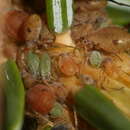pt-BR
nomes no trilho de navegação


Cinara pilicornis, the spruce shoot aphid[1] or brown spruce shoot aphid, is an aphid species in the genus Cinara found on Norway spruce (Picea abies) and Sitka spruce (Picea sitchensis).[2] It is a quite large aphid species with a plump, dull brown body. It seems to have little effect on the tree. It is a European species but it has also been reported in spruce forests in New Zealand, together with the spruce aphid (Elatobium abietinum).[3]
C. pilicornis, which is attended by the honeydew-collecting ants Formica polyctena,[4] is seldom attacked by the parasitoid wasp Pauesia pini.[5] It is also a host for Entomophthora fungi.[2]
C. pilicornis produces the trisaccharide melezitose. Citronellol, cis–trans-nepetalactone and cis–trans-nepetalactol are stress-induced compounds released by the host plant. These compounds originated from the aphids and they are assumed to be pheromone components for this aphid species.[6]
Cinara pilicornis, the spruce shoot aphid or brown spruce shoot aphid, is an aphid species in the genus Cinara found on Norway spruce (Picea abies) and Sitka spruce (Picea sitchensis). It is a quite large aphid species with a plump, dull brown body. It seems to have little effect on the tree. It is a European species but it has also been reported in spruce forests in New Zealand, together with the spruce aphid (Elatobium abietinum).
C. pilicornis, which is attended by the honeydew-collecting ants Formica polyctena, is seldom attacked by the parasitoid wasp Pauesia pini. It is also a host for Entomophthora fungi.
C. pilicornis produces the trisaccharide melezitose. Citronellol, cis–trans-nepetalactone and cis–trans-nepetalactol are stress-induced compounds released by the host plant. These compounds originated from the aphids and they are assumed to be pheromone components for this aphid species.
Grenisprotalús, (fræðiheiti; Cinara pilicornis)[1] er lúsartegund í ættkvíslinni Cinara og finnst á rauðgreni (Picea abies) og Sitkagreni (Picea sitchensis).[2] Þetta er tiltölulega stór plöntulúsartegund með breiðum, fölbrúnum búk. Hún virðist hafa lítil áhrif á trén. Þetta er evrópsk tegund, en hefur einnig verið tilkynnt í greniskógum í Nýja Sjálandi, ásamt sitkalús (Elatobium abietinum).[3]
Hún er algeng um allt land, en veldur litlum skaða.[4]
Grenisprotalús, (fræðiheiti; Cinara pilicornis) er lúsartegund í ættkvíslinni Cinara og finnst á rauðgreni (Picea abies) og Sitkagreni (Picea sitchensis). Þetta er tiltölulega stór plöntulúsartegund með breiðum, fölbrúnum búk. Hún virðist hafa lítil áhrif á trén. Þetta er evrópsk tegund, en hefur einnig verið tilkynnt í greniskógum í Nýja Sjálandi, ásamt sitkalús (Elatobium abietinum).